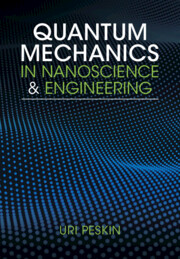Book contents
- Quantum Mechanics in Nanoscience and Engineering
- Additional material
- Quantum Mechanics in Nanoscience and Engineering
- Copyright page
- Contents
- Preface: Who Can Benefit from Reading This Book?
- 1 Motivation
- 2 The State of a System
- 3 Observables and Operators
- 4 The Schrödinger Equation
- 5 Energy Quantization
- 6 Wave Function Penetration, Tunneling, and Quantum Wells
- 7 The Continuous Spectrum and Scattering States
- 8 Mechanical Vibrations and the Harmonic Oscillator Model
- 9 Two-Body Rotation and Angular Momentum
- 10 The Hydrogen-Like Atom
- 11 The Postulates of Quantum Mechanics
- 12 Approximation Methods
- 13 Many-Electron Systems
- 14 Many-Atom Systems
- 15 Quantum Dynamics
- 16 Incoherent States
- 17 Quantum Rate Processes
- 18 Thermal Rates in a Bosonic Environment
- 19 Open Quantum Systems
- 20 Open Many-Fermion Systems
- Index
- References
6 - Wave Function Penetration, Tunneling, and Quantum Wells
Published online by Cambridge University Press: 11 May 2023
- Quantum Mechanics in Nanoscience and Engineering
- Additional material
- Quantum Mechanics in Nanoscience and Engineering
- Copyright page
- Contents
- Preface: Who Can Benefit from Reading This Book?
- 1 Motivation
- 2 The State of a System
- 3 Observables and Operators
- 4 The Schrödinger Equation
- 5 Energy Quantization
- 6 Wave Function Penetration, Tunneling, and Quantum Wells
- 7 The Continuous Spectrum and Scattering States
- 8 Mechanical Vibrations and the Harmonic Oscillator Model
- 9 Two-Body Rotation and Angular Momentum
- 10 The Hydrogen-Like Atom
- 11 The Postulates of Quantum Mechanics
- 12 Approximation Methods
- 13 Many-Electron Systems
- 14 Many-Atom Systems
- 15 Quantum Dynamics
- 16 Incoherent States
- 17 Quantum Rate Processes
- 18 Thermal Rates in a Bosonic Environment
- 19 Open Quantum Systems
- 20 Open Many-Fermion Systems
- Index
- References
Summary
Scanning tunneling microscopy is introduced as an analytic tool for characterizing nanostructures and dynamics on the nanoscale. To analyze the underlying tunneling phenomenon, the Schrödinger equation is solved for a particle confined between finite potential energy steps. For a single potential energy well, the proper solutions to the Schrödinger equation are similar to those of a particle in an infinite box, except for the emerging “tails” of the stationary wave functions in the “classically forbidden” regions of the external confining potentials. For a symmetric double well potential, wave function penetration of the stationary solutions manifests in their even distribution among the wells. An attempt to localize the particle in one of them would lead to periodic oscillations between the wells, as if the particle can “tunnel” under the separating energy barrier. The wave function penetration and tunneling phenomena are discussed also in relation to energy band formation in periodic lattices.
Keywords
Information
- Type
- Chapter
- Information
- Quantum Mechanics in Nanoscience and Engineering , pp. 46 - 60Publisher: Cambridge University PressPrint publication year: 2023
